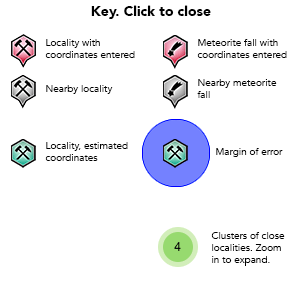Prince of Wales Mine, Sebastopol, City of Ballarat, Victoria, Australia

| Latitude & Longitude (WGS84): | 37° 36' 44'' South , 143° 49' 54'' East |
|---|---|
| Latitude & Longitude (decimal): | -37.61226,143.83177 |
| GeoHash: | G#: r1q60bzhe |
| Locality type: | Mine (Built Over) - last checked 2018 |
| Köppen climate type: | Cfb : Temperate oceanic climate |
The Prince of Wales Mine was historically the second highest alluvial gold producer on the Ballarat Goldfield at 168 929 ounces.
The company was registered in 1859, with mining starting in 1862. It was a co-operative of 61 members, formed to mine alluvial gold on Cobblers Lead. The Bonshaw Claim adjoined to the south, and the Working Miners claim to the north.
A shaft was sunk, then drive towards the gutter, but all they found was flooding amounts of water. The company struggled for two years, purchasing ever larger and numbers of pumps. The water problem was temporarily overcome, finding much gold in the gutter, and paying dividends. Alexander Dempster and F.W. Tatham were early mine managers.
A riot broke out in 1868, when striking miners tried to prevent workers from entering the mine. In 1874, a dispute arose with the Bonshaw Company who objected to the Prince of Wales pumping sludge onto their property. Around the same time the Prince of Wales broke into the Working Miners underground mine, both companies claiming the ground as their own. Barricades were erected underground, with miners facing off at each other.
In 1862, the Prince of Wales reef was discovered, with soon a 16 stamp battery erected. In 1865, a new battery of 40 stamps was erected. A second shaft was sunk in 1867.
Water again was becoming a problem, with the mine let to tributers who abandoned it. Meanwhile the company leased 100 acres nearby from Jock Winter's pastoral land, naming the mine the United Albion, but with little success. All operations had ground to a halt by 1878.
A new company was formed in 1882, merging the Prince of Wales and Bonshaw leases. The Bonshaw Freehold Company began in 1858 as a co-operative of 46 shareholders. They leased 180 acres from Jock Winter for five years. The mine manager was W.M. Acheson.
In 1862, the company purchased the land, and sank a second shaft, a half mile north-west of the first shaft. By the mid 1860's, large amounts of money was being invested into the company by Ballarat speculators and capitalists. The mine in its own right produced 96 520 ounces of alluvial gold, the sixth highest for the Ballarat goldfield.
When the leases merged in 1882, it covered 500 acres, with the company planning to sink a new shaft. J.A. Chalk is mine manager. A shareholder meeting in 1889 states operations had been suspended 'for some time'.
A new company was formed in 1891 over both leases. There was only a small number of shareholders, and limited capital. A new battery was erected, with operation confined to the 500 foot level on the reef found by the original Prince of Wales company. Little gold was found, and the company lasted until around 1900.
The Prince of Wales #1 shaft is south of the Miles and Grant streets intersections, as disturbed ground and mullock heaps, partially obscured by trees, in the middle of a paddock. #2 shaft is several hundred metres west north-west, also in a paddock and south of Miles Street. #3 is just south of the Worldmark Resort (former St Josephs boys home). Little can be seen at the latter two.
Select Mineral List Type
Standard Detailed Strunz Dana Chemical ElementsMineral List
Mineral list contains entries from the region specified including sub-localities1 valid mineral.
Detailed Mineral List:
| ⓘ Gold Formula: Au Reference: Centenary Gold Monument plaque, Sturt and Albert streets, Ballarat. |
List of minerals arranged by Dana 8th Edition classification
| Group 1 - NATIVE ELEMENTS AND ALLOYS | |||
|---|---|---|---|
| Metals, other than the Platinum Group | |||
| ⓘ | Gold | 1.1.1.1 | Au |
Regional Geology
This geological map and associated information on rock units at or nearby to the coordinates given for this locality is based on relatively small scale geological maps provided by various national Geological Surveys. This does not necessarily represent the complete geology at this locality but it gives a background for the region in which it is found.
Click on geological units on the map for more information. Click here to view full-screen map on Macrostrat.org
| Holocene - Miocene 0 - 23.03 Ma ID: 704630 | Newer Volcanic Group Age: Cenozoic (0 - 23.03 Ma) Stratigraphic Name: Newer Volcanic Group Description: Cinder cones - scoria, minor ash and agglutinates; Lava flows - tholeiitic to minor alkaline and basanitic lavas. Comments: igneous mafic volcanic; synthesis of multiple published descriptions Lithology: Igneous mafic volcanic Reference: Raymond, O.L., Liu, S., Gallagher, R., Zhang, W., Highet, L.M. Surface Geology of Australia 1:1 million scale dataset 2012 edition. Commonwealth of Australia (Geoscience Australia). [5] |
| Early Silurian - Cambrian 427.4 - 541 Ma ID: 3185333 | Paleozoic sedimentary rocks Age: Paleozoic (427.4 - 541 Ma) Comments: Lachlan Fold Belt Lithology: Sedimentary rocks Reference: Chorlton, L.B. Generalized geology of the world: bedrock domains and major faults in GIS format: a small-scale world geology map with an extended geological attribute database. doi: 10.4095/223767. Geological Survey of Canada, Open File 5529. [154] |
Data and map coding provided by Macrostrat.org, used under Creative Commons Attribution 4.0 License
References
Sort by
Year (asc) Year (desc) Author (A-Z) Author (Z-A)Localities in this RegionShow map
- Victoria
- City of Ballarat
- Sebastopol
- Prince of Wales Mine
- Sebastopol
- City of Ballarat



